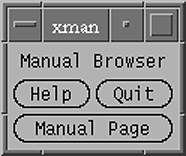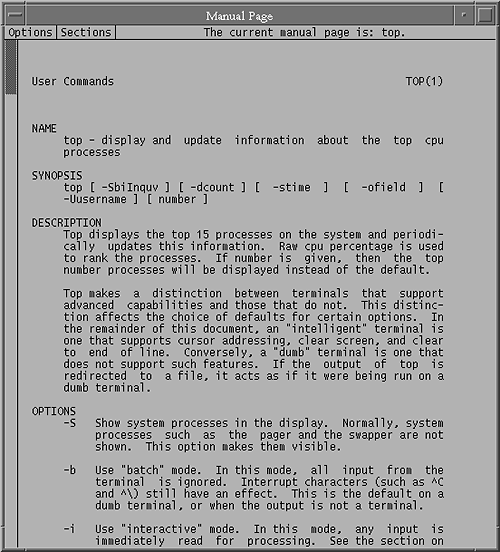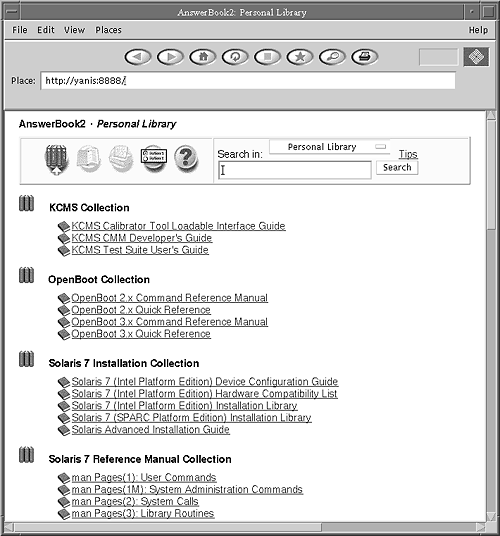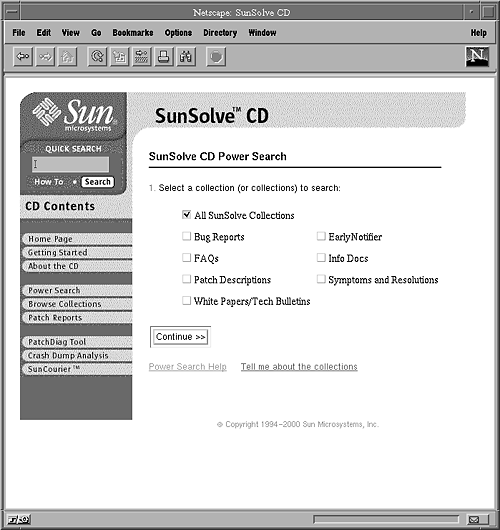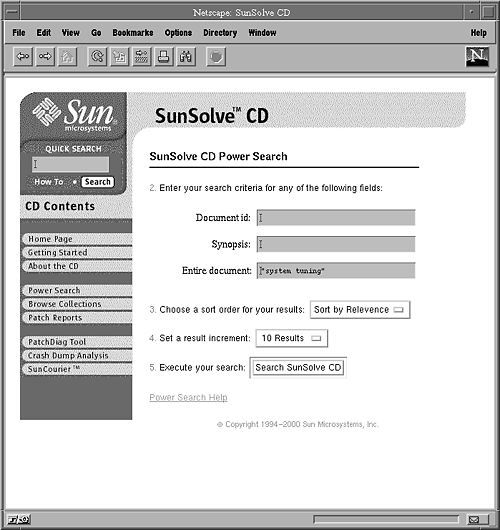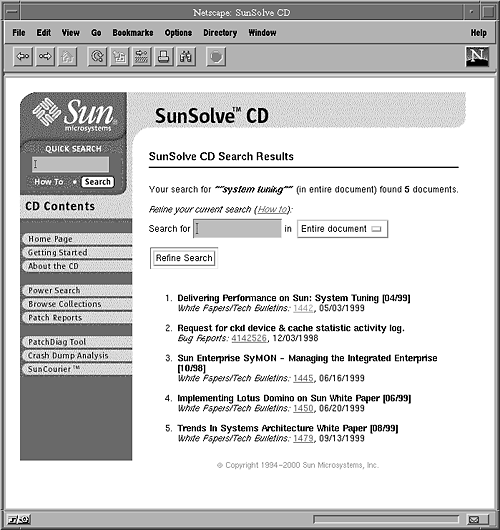Getting Help
| The days of wading through countless hard-copy computer manuals are over. A vast amount of information and documentation is available, if you know where to find it and have the necessary access. This section discusses sources of information and help that can answer virtually any Sun- or Solaris- related question and satisfy virtually any requirement ”all without you picking up a single book. Online Manual PagesA comprehensive set of manual pages is supplied with the Solaris operating environment, but they are installed by default only with the Developer and Entire Distribution configuration options. They contain online help for all the available commands, programming functions, and procedures, as well as a number of configuration files, such as syslog.conf, used for configuring the system-logging daemon, syslogd. The base directory location for the manual pages is normally /usr/share/man or /usr/man. (/usr/man is a symbolic link to /usr/share/man, the physical location of the manual pages.) The majority of applications installed as Solaris packages also contain manual pages for the specific product. Most of the public domain software installs manual pages by default to the directory /usr/local/man. You can access these extra pages in two ways: by choosing the /usr/share/man location for help files as part of the package installation, or by appending the location of the manual pages (in this example, /usr/local/man) to the variable MANPATH . Online manual pages can be accessed from the shell (command line) using the man command ”or, if you're in a windowing environment such as OpenWindows or CDE, there is also a GUI version called xman . Figure A.1 shows the xman window that appears. Figure A.1. The small size of the initial window is ideal for keeping it on the desktop for the duration of the session. xman uses the MANPATH variable to search for valid locations of manual pages. Figure A.2 shows the manual page for the top command, a public domain utility that installs by default into /usr/local. Figure A.2. The scrollbar facility allows easy navigation of the entire manual page. Answerbook SoftwareA CD-ROM containing documentation is supplied with the Solaris operating environment. This information contains Solaris manuals, which are fully searchable so that queries can be run against the entire set, showing only the relevant parts of each guide. The Answerbook CD-ROM also contains the manual pages. Figure A.3 shows the initial screen that is displayed when the Answerbook software is started, which is done by selecting the Answerbook2 option from the workspace Help menu. Figure A.3. The fully searchable documentation collections eliminate the need to look in several different locations for the required information. SunsolveSunsolve provides important information and resources for Sun customers, including Solaris patches, a comprehensive symptoms and resolution database, white papers, information documents, bug reports , frequently asked questions (FAQ), and an early notification section. These are all available to customers with a SunSpectrum support contract and can be accessed in either of two ways: on the World Wide Web, or using a set of CD-ROMs that are sent to the system manager or administrator on a regular basis. To use Sunsolve online, go to http://sunsolve.sun.com and register. You will need the SunSpectrum contract number to gain full access to all the resources listed previously. Even if you don't have a current SunSpectrum support contract, you can access a limited set of resources, including free patches and descriptions, patch reports, StarOffice support, and Sun security bulletins . Figure A.4 shows the online user interface that is displayed for non-SunSpectrum account holders. Figure A.4. Sun provides access to important information and resources even if you don't have a current support contract. The Sunsolve CD-ROMs (currently four per issue) contain the Sunsolve database as well as three CD-ROMs of patches. To use the Sunsolve CD-ROM, simply insert it into the CD drive. If you are using volume management, then the file manager window will appear and the sunsolve command can be executed. This starts a Netscape window. Choose the Power Search option to look for specific information. Figure A.5 shows the initial screen where you select the scope of the search. Figure A.5. The scope of the query can be easily customized to suit user requirements. Next, enter the required search criteria. As an example, I entered a search for information from all the available collections on "system tuning." Figure A.6 shows this screen. Figure A.6. Sunsolve provides flexibility in searching by using keywords or text strings. When the criteria has been entered, the search of the Sunsolve database executes. The resulting references to Sunsolve documents are then shown. The results for the example query on "system tuning" are shown in Figure A.7. Figure A.7. The results can be viewed by clicking on the relevant hyperlink ”or, if too many results are shown, the query can be refined. Sun Documentation OnlineSun Microsystems makes available a vast amount of product documentation on the World Wide Web at http://docs.sun.com. The site is fully searchable and contains support for many different languages. A large number of the manuals can be downloaded as PDF files for subsequent reading or printing using Adobe Acrobat Reader. A useful feature of the site is that it contains a number of contexts through which refined searches can be carried out. Four main categories can be used for searching:
The Sun product documentation site contains a comprehensive help facility to aid effective searching and also offers the option to select from the most frequently requested information, such as Solaris 8 or enterprise servers. Further ReadingClark, Tom. Designing Storage Area Networks . Addison-Wesley, 1999. Freeland, Curt. Solaris 8 for Managers and Administrators . Delmar, 2000. Kasper, Paul and Alan McClellan. Automating Solaris Installations ”A Custom Jumpstart Guide . Sunsoft/Prentice Hall, 1995. Laurie, Ben andPeter Laurie. Apache ”The Definitive Guide . O'Reilly, 1999. Lewis, Lundy. Service Level Management for Enterprise Networks . Artech House, 1999. Loshin, Peter. IPv6 Clearly Explained . AP Professional, 1998. Salus, Peter. A Quarter Century of Unix . Addison Wesley, 1994. (This is an excellent book if you want to know the real history of the operating system and how Sun Microsystems came into existence.) Siever, Spainhour, and Patwardhan. Perl in a Nutshell . O'Reilly, 1999. Sturm, Rick. Foundations of Service Level Management . Sams Publishing, 2000. |
| Top |
EAN: 2147483647
Pages: 101
